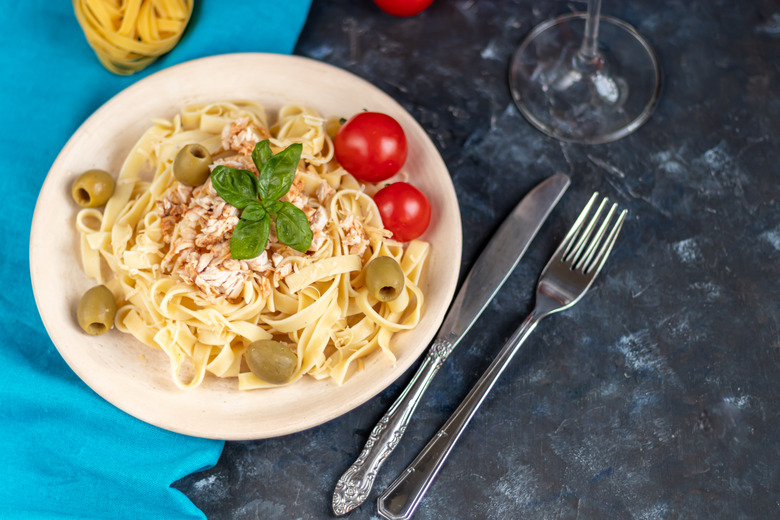A Cream Cheese And Olive Spread That Doubles As A Pasta Sauce
A Cream Cheese And Olive Spread That Doubles As A Pasta Sauce
A couple of years ago I started making a three-ingredient spread that has seen Jackie and me through many, many sessions of pre-dinner drinks. It is simply a mash of olives and cream cheese, brightened with lemon zest. (I didn’t realize at the time that something similar actually existed: I’ve looked at other recipes and immodestly prefer my own for its simplicity, its high olive content and its lemon zest.)Using good olives and good cream cheese – preferably a fresh, properly tart and cheeselike smaller-production variety such as Ben’s from upstate New York – yields a spread that can shmeared on Scandinavian-style rye bread, dense pumpernickel or crispbread, either by itself or even topped with smoked salmon: the olives and lemon zest make sense with smoked fish.What if I make too much or don’t serve enough of it? The leftovers – all by themselves – make a dandy buttery-tasting (though butterless) olive-cream sauce for pasta. Do not scoff: Think of delicious pasta sauces made of other cheeses and little else, like the Roman cacio e pepe or my beloved gorgonzola and arugula. And there’s rarely a down side to olives.So make the spread and then make the pasta.Serves many as a spread; the leftovers (two thirds of the total quantity) will serve two as a main-course spaghetti sauce (or four as a pasta starter)

Ingredients
- 1 cup (about 1/2 lb.) flavorful cream cheese
- 2/3 cup drained pitted olives of your choice
- grated zest of 1/2 a lemon, plus a similar quantity for garnishing the pasta
- two portions of pasta: thick spaghetti is ideal
Directions
- Remove the cream cheese from the fridge 20 or 30 minutes in advance to soften it.
- Save yourself a trip to the dentist: Make sure the “pitted” olives really are pitted, every single one of them. Even if you’ve pitted them yourself, double check.
- Put the olives into the bowl of a food processor fitted with the metal chopping blade. Pulse once, then again, listening for the rattling noise that would indicate yet another stray olive pit. If you hear it, remove the bowl from the machine and go through the partially chopped olives with your fingers to locate and remove the pit.
- Now add the grated lemon zest and pulse a couple of times more until the olives are chopped medium-fine.
- Add the cream cheese and pulse the machine until the ingredients are well combined, scraping down the sides of the bowl as needed. Some olives will be pureed, others thoroughly chopped, and it is this range of textures that almost dictates using a food processor rather than a knife to deal with the olives. The color will depend on your choice of olives; it is unlikely to be beautiful.
- You can use about 1/3 of the mixture to spread onto dense, thin-sliced bread for canapés.
- When you wish to make the pasta, bring salted water to the boil and add the spaghetti.
- While this is cooking, put the remaining 2/3 of the cream cheese mixture into a skillet, add 1/2 cup of the pasta cooking liquid and melt everything over medium-low heat, stirring with a whisk or rubber spatula as it softens.
- When the pasta is done, drain it (reserving a cup of the cooking water) and add it to the skillet, stirring and tossing with tongs to coat the pasta. Use some of that pasta water to adjust the consistency if necessary; last time I made it, another 1/3 cup was needed. It is unlikely to need salt, but taste to verify. Serve in warmed bowls, sprinkled with grated lemon zest.